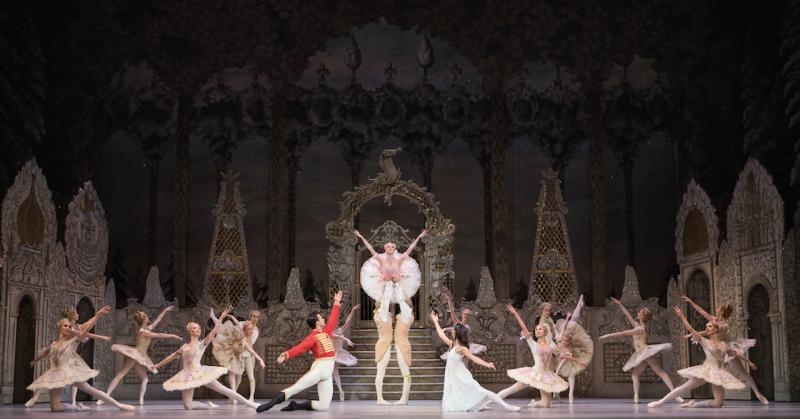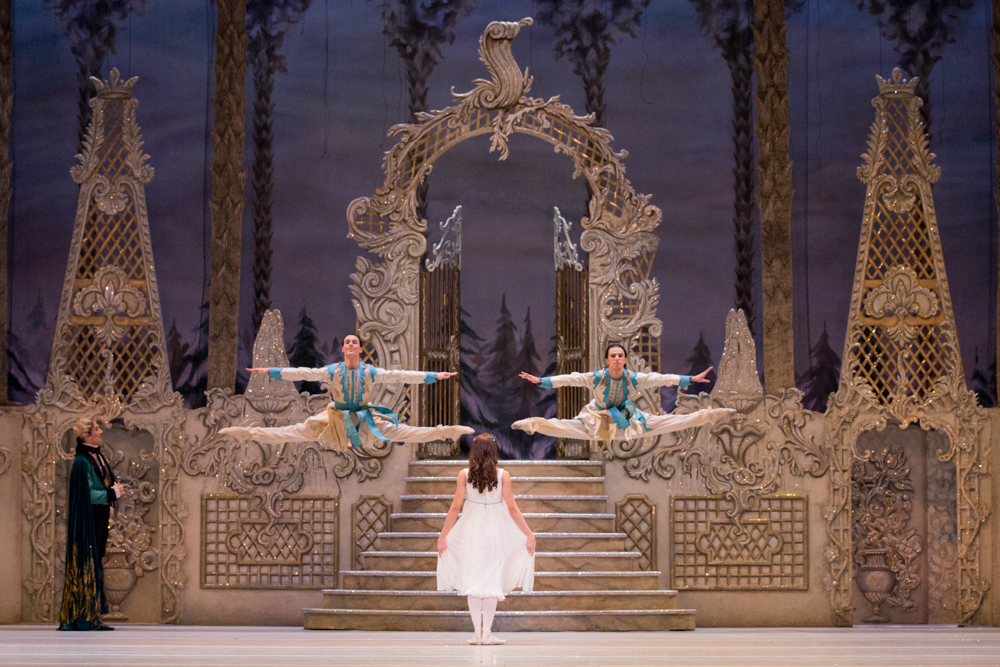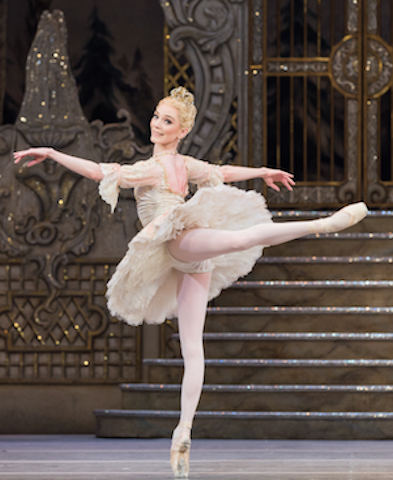The Nutcracker, Royal Ballet review - superb start to the festive dance season | reviews, news & interviews
The Nutcracker, Royal Ballet review - superb start to the festive dance season
The Nutcracker, Royal Ballet review - superb start to the festive dance season
Tchaikovsky's grand and gorgeous classic gets the five-star treatment

For some people, the festive season starts with The Nutcracker. And as it happens, this year the opening night of Sir Peter Wright’s production for the Royal Ballet was also the performance beamed live to hundreds of cinemas around the UK and many more around the world.
But then, these dancers are in their comfort zone in this particular show, which exploits all the things the Royal is best at: naturalistic drama combined with a coolly restrained classicism, and a sense (however carefully manufactured) of being grandly at ease in a stage world that gaily includes expanding furniture and battalions of mice on its way to one of the most heart-stopping grand pas de deux in the canon. It helps, too, to have an ace house orchestra when the score is as good as Tchaikovsky’s.
 Some ballet companies change their staging of the Christmas classic as a family might change its car: English National Ballet has had 10 versions in 65 years and frankly could do with a new one. The Royal has stayed loyal to Wright’s production since 1984 and, since a recent overhaul, it is now definitive. The usual gripe about Nutcracker being an uneven game of two halves – the first all story and no dancing, the second all dancing and no story – no longer applies. Wright’s integrating of Clara and her beau into the national dances of Act II makes for a near-perfect balance, rendering the whole thing vastly more palatable for children, and adding depth and texture all round.
Some ballet companies change their staging of the Christmas classic as a family might change its car: English National Ballet has had 10 versions in 65 years and frankly could do with a new one. The Royal has stayed loyal to Wright’s production since 1984 and, since a recent overhaul, it is now definitive. The usual gripe about Nutcracker being an uneven game of two halves – the first all story and no dancing, the second all dancing and no story – no longer applies. Wright’s integrating of Clara and her beau into the national dances of Act II makes for a near-perfect balance, rendering the whole thing vastly more palatable for children, and adding depth and texture all round.
Some of the subtler innovations are fun to spot. Every feature of the enchanted second half is now presaged in the real world of the first. The Spanish, Arabian, Chinese and Russian dancers are first glimpsed as fancy-dress attendants on St Nicholas, dispensing sweets for the children at the Stahlbaum’s party. During the mouse battle these same characters can be seen taking up comfortable viewing positions in the newly enlarged dolls’ house, appalled and thrilled by the carnage like tourists at the Battle of Waterloo.
Gary Avis is a superb Master of Ceremonies, throwing off real magic tricks with aplomb but, more importantly, appearing to think on his feet
Another distinction of Wright’s handling of the 1892 scenario (only a fraction of the original ballet survives), is his positioning of Herr Drosselmeyer, party entertainer and maker of clockwork toys, as the engine of the story. It is Drosselmeyer who opens and closes the show; it is he who induces young Clara to rescue his nephew, the soldier Hans-Peter, from a curse, and who transports them to Sugar Plum country, and supervises the international dance show (pictured above) put on in their honour. Tchaikovsky almost certainly identified personally with this character, he himself being a devoted uncle and generator of magic in more ways than one.
Gary Avis is superb in the role, throwing off real magic tricks with aplomb but, more importantly, appearing to think on his feet. We see and share in his delight at his own ingenuity. But even the most minor characters in the Stahlbaum’s drawing room have a truthfulness about them, from the fond parents and fussing aunts to the curmudgeonly grandpa in his embarrassing knitted hat. Even the nameless hordes of children are individually sweet or annoying.
Francesca Hayward (pictured above) has the advantage of being able to look about 12 or 13 without simpering, and it’s not until Clara's pas de deux, after she has raised up her Nutcracker Prince from his battle injury, that we get her full measure as an actor-dancer. Then, wow, does she take off! What is always a lump-in-throat moment – it’s the music – Hayward makes utterly thrilling as she conveys the first stirrings of adult love through Wright’s soaring lifts and turns. Alexander Campbell partners strongly but it’s later that he shows his distinctive quality, when he mimes everything that has happened to him thus far, nasty bristling rat whiskers and all. The Reduced Nutcracker indeed, in 30 seconds flat.
 The national dances spring no surprises. Melissa Hamilton is dangerously snakelike in Arabian, an impression helped by a wondrously sustained pianissimo from the orchestra under Barry Wordsworth. And the Chinese dance has at last mercifully shed the remaining vestiges of dodgy racial indicators. The plaits and costumes do the job without comedy pointy fingers. The Waltz of the Flowers, as the most extended dance number, works beautifully to prepare us, mentally as well as visually, for the grand classicism of the grand pas de deux. Yasmine Naghdi is again an exemplary Rose Fairy, as light as a whiff of scent. And I do believe I’ve never seen crisper double tours from her four escorts. There wasn't a fudged jump between them.
The national dances spring no surprises. Melissa Hamilton is dangerously snakelike in Arabian, an impression helped by a wondrously sustained pianissimo from the orchestra under Barry Wordsworth. And the Chinese dance has at last mercifully shed the remaining vestiges of dodgy racial indicators. The plaits and costumes do the job without comedy pointy fingers. The Waltz of the Flowers, as the most extended dance number, works beautifully to prepare us, mentally as well as visually, for the grand classicism of the grand pas de deux. Yasmine Naghdi is again an exemplary Rose Fairy, as light as a whiff of scent. And I do believe I’ve never seen crisper double tours from her four escorts. There wasn't a fudged jump between them.
The segue into the grand pas always seems to me rather sudden. But that’s how the music goes, and if any couple can make it work, Sarah Lamb and Steven McRae can. Perfectly matched in both scale and dynamic, these two are the business. Lamb (pictured above, right) recalls Lesley Collier in her glorious prime, McRae the godlike young Anthony Dowell. Together they give a masterclass in the refinement and poise that comes of a lifetime’s commitment to technique. A special evening, then. And tens of thousands got to see it.
rating
Explore topics
Share this article
The future of Arts Journalism
You can stop theartsdesk.com closing!
We urgently need financing to survive. Our fundraising drive has thus far raised £49,000 but we need to reach £100,000 or we will be forced to close. Please contribute here: https://gofund.me/c3f6033d
And if you can forward this information to anyone who might assist, we’d be grateful.

Subscribe to theartsdesk.com
Thank you for continuing to read our work on theartsdesk.com. For unlimited access to every article in its entirety, including our archive of more than 15,000 pieces, we're asking for £5 per month or £40 per year. We feel it's a very good deal, and hope you do too.
To take a subscription now simply click here.
And if you're looking for that extra gift for a friend or family member, why not treat them to a theartsdesk.com gift subscription?
more Dance
 'We are bowled over!' Thank you for your messages of love and support
Much-appreciated words of commendation from readers and the cultural community
'We are bowled over!' Thank you for your messages of love and support
Much-appreciated words of commendation from readers and the cultural community
 R:Evolution, English National Ballet, Sadler's Wells review - a vibrant survey of ballet in four acts
ENB set the bar high with this mixed bill, but they meet its challenges thrillingly
R:Evolution, English National Ballet, Sadler's Wells review - a vibrant survey of ballet in four acts
ENB set the bar high with this mixed bill, but they meet its challenges thrillingly
 Like Water for Chocolate, Royal Ballet review - splendid dancing and sets, but there's too much plot
Christopher Wheeldon's version looks great but is too muddling to connect with fully
Like Water for Chocolate, Royal Ballet review - splendid dancing and sets, but there's too much plot
Christopher Wheeldon's version looks great but is too muddling to connect with fully
 iD-Reloaded, Cirque Éloize, Marlowe Theatre, Canterbury review - attitude, energy and invention
A riotous blend of urban dance music, hip hop and contemporary circus
iD-Reloaded, Cirque Éloize, Marlowe Theatre, Canterbury review - attitude, energy and invention
A riotous blend of urban dance music, hip hop and contemporary circus
 How to be a Dancer in 72,000 Easy Lessons, Teaċ Daṁsa review - a riveting account of a life in dance
Michael Keegan-Dolan's unique hybrid of physical theatre and comic monologue
How to be a Dancer in 72,000 Easy Lessons, Teaċ Daṁsa review - a riveting account of a life in dance
Michael Keegan-Dolan's unique hybrid of physical theatre and comic monologue
 A Single Man, Linbury Theatre review - an anatomy of melancholy, with breaks in the clouds
Ed Watson and Jonathan Goddard are extraordinary in Jonathan Watkins' dance theatre adaptation of Isherwood's novel
A Single Man, Linbury Theatre review - an anatomy of melancholy, with breaks in the clouds
Ed Watson and Jonathan Goddard are extraordinary in Jonathan Watkins' dance theatre adaptation of Isherwood's novel
 Peaky Blinders: The Redemption of Thomas Shelby, Rambert, Sadler's Wells review - exciting dancing, if you can see it
Six TV series reduced to 100 minutes' dance time doesn't quite compute
Peaky Blinders: The Redemption of Thomas Shelby, Rambert, Sadler's Wells review - exciting dancing, if you can see it
Six TV series reduced to 100 minutes' dance time doesn't quite compute
 Giselle, National Ballet of Japan review - return of a classic, refreshed and impeccably danced
First visit by Miyako Yoshida's company leaves you wanting more
Giselle, National Ballet of Japan review - return of a classic, refreshed and impeccably danced
First visit by Miyako Yoshida's company leaves you wanting more
 Quadrophenia, Sadler's Wells review - missed opportunity to give new stage life to a Who classic
The brilliant cast need a tighter score and a stronger narrative
Quadrophenia, Sadler's Wells review - missed opportunity to give new stage life to a Who classic
The brilliant cast need a tighter score and a stronger narrative
 The Midnight Bell, Sadler's Wells review - a first reprise for one of Matthew Bourne's most compelling shows to date
The after-hours lives of the sad and lonely are drawn with compassion, originality and skill
The Midnight Bell, Sadler's Wells review - a first reprise for one of Matthew Bourne's most compelling shows to date
The after-hours lives of the sad and lonely are drawn with compassion, originality and skill
 Ballet to Broadway: Wheeldon Works, Royal Ballet review - the impressive range and reach of Christopher Wheeldon's craft
The title says it: as dancemaker, as creative magnet, the man clearly works his socks off
Ballet to Broadway: Wheeldon Works, Royal Ballet review - the impressive range and reach of Christopher Wheeldon's craft
The title says it: as dancemaker, as creative magnet, the man clearly works his socks off
 The Forsythe Programme, English National Ballet review - brains, beauty and bravura
Once again the veteran choreographer and maverick William Forsythe raises ENB's game
The Forsythe Programme, English National Ballet review - brains, beauty and bravura
Once again the veteran choreographer and maverick William Forsythe raises ENB's game

Add comment